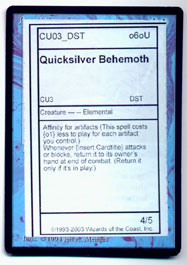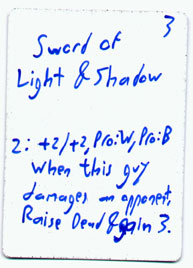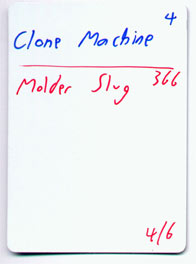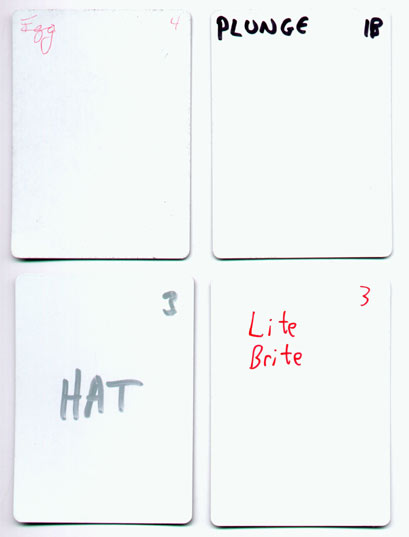A-Proxy-Mation
When I was playing Magic casually back in 1994 and '95, my friends and I never used proxy cards—if I wanted to build a deck based around Tawnos's Coffin and Wrath of God, I had to go out and trade for or buy several copies of each.
When I first started working here at Wizards, however, I found that R&D uses proxies all the time to test cards. Obviously, the cards that are in development need to be proxied, but I was surprised to find out that R&D didn't get upcoming sets much sooner than the rest of the world did. (For example, we still don't have Fifth Dawn cards here yet, and must still play with proxies of them.)
Substantial Substitutes
The best kind of proxy card, and the one you're most familiar with if you read the site enough, are the “playtest stickers.” Here is a playtest sticker of Quicksilver Behemoth used during Darksteel development:

These stickers are printed directly from our card database in large numbers, and then we all sit around and stick them on the appropriately-colored leftover cards from older sets. The stickers are printed up usually about once a month and are used almost exclusively for limited (sealed deck and draft) playtesting.
The stickers, while nice, take substantial effort to print and fasten. So much so that we can't realistically use them when we're playtesting constructed decks. During constructed testing, card text and deck contents are constantly changing—often from one hour to the next—and the stickers become obsolete really quickly. Instead, we have a supply of blank cards handy—normal cards with the Magic back and plain white fronts—that we write on when we make decks.
One way to make good proxies is to write all the relevant information on the card, like developer Devin Low did here:

Devin—and any one he plays against—never had any problems remembering what this card was supposed to do, since he spent a lot of time making sure it was clear. The problem is that this method takes way too much time. It would almost be faster to print and cut stickers than to write all this information on every proxy card.
So we take shortcuts, often writing just names and mana costs, and relying on playtesters' knowledge of what cards do. Now, this system would work really well if everyone in R&D had good penmanship. But alas, people's ideas on what makes a decent proxy vary greatly. Have a look at these three cards:

All three are proxies of the same card, Darksteel's Viridian Zealot. The card was known as “Cool Cat” during early development. The first proxy is from Developer A. Developer A's proxy contains the bare minimum information he needs to play the card: a mana cost and the name he knows it by, “Cool Cat.” If you were wondering, this proxy was made long after Darksteel had gone to press and Cool Cat was given his real name. But many playtest names just stick and R&D never stops using them. If you play against Developer A, be ready to ask him what his cards are five times per game. But his system does allow him to make and edit decks at breakneck speed.
The middle one is by Developer B. Developer B has bigger handwriting, so at least you can tell it's called “Cool Cat,” and hopefully you'd remember what card Cool Cat was as well as what its abilities were. He also was kind enough to write the creature's power and toughness, so that if it gets into combat, the math is easier.
The third proxy is by Developer C, and it is a thing of beauty. The green Sharpie clearly indicates that the card is green. The real name (for which the creative team thanks him dearly) is written neatly in the center, and the mana cost and P/T are also very readable from across the table. While this is not a proxy that I made, it is close to how I try to create them. I, like many developers, keep a wide range of colored pens at my desk at all times. I'm sure I spend more time than is necessary on my proxy decks, but it really increases my own play experience. I like my cards to look nice.
I'll let the (cool) cat out of the bag: Developer A is newly anointed Magic Lead Developer Brian Schneider, Developer B is Matt Place, and Developer C is Paul Sottosanti. Paul is very particular, Matt a little less so, and Brian is all substance-over-form. (He probably made four new decks since I started writing this article.) We tried to persuade him to use real card names for a while, but he ended up writing “Glaivemaster” for Auriok Steelshaper and “Voltron” for Auriok Glaivemaster, which was worse than whatever he was doing before. He leaves the names up to other people.
Things can get even worse. For a while we were really low on blank cards and had to reuse them. This Magic Arcana shows what happened then, and was not pretty. Cross out Basking Rootwalla, change it to Rorix Bladewing. Then cross that out and change it to Laquatus's Champion. Yuck. We still make changes directly on cards within a deck, but we don't need to turn one deck into another any more just to ration blanks.
Of course, some people try to save time in other ways. Here's a card Devin used during Mirrodin development:

He had two deck ideas that were similar, and tried to save time by making one deck into both versions. In one game he'd play all the top halves, and in other he'd use the bottoms. While a sound idea, in practice it was way too confusing to play against.
A Glimpse Ahead
You really have to know future card sets well in order to understand Magic games here in R&D. To prove it, I'm going to show you a few Fifth Dawn cards taken from recent Future Future League decks. If you're wondering what they do, so do many of the other developers that have played against these cards!

Last Week's Poll
| What set did your favorite Wall first appear in? | ||
| Urza's block | 2179 | 20.2% |
| Alpha | 1202 | 11.1% |
| Tempest block | 1119 | 10.4% |
| Early expansions | 962 | 8.9% |
| None – Walls are dumb. | 909 | 8.4% |
| Mirrodin block | 903 | 8.4% |
| Mirage block | 738 | 6.8% |
| Masques block | 723 | 6.7% |
| Ice Age block | 667 | 6.2% |
| Onslaught block | 548 | 5.1% |
| Invasion block | 514 | 4.8% |
| Odyssey block | 334 | 3.1% |
| Total | 10798 | 100.0% |
Wow, Urza's Walls won? Yawgmoth's Will wasn't a Wall! Honestly, I have to wonder if people even read the question!
Aaron may be reached at latestdevelopments@wizards.com.

